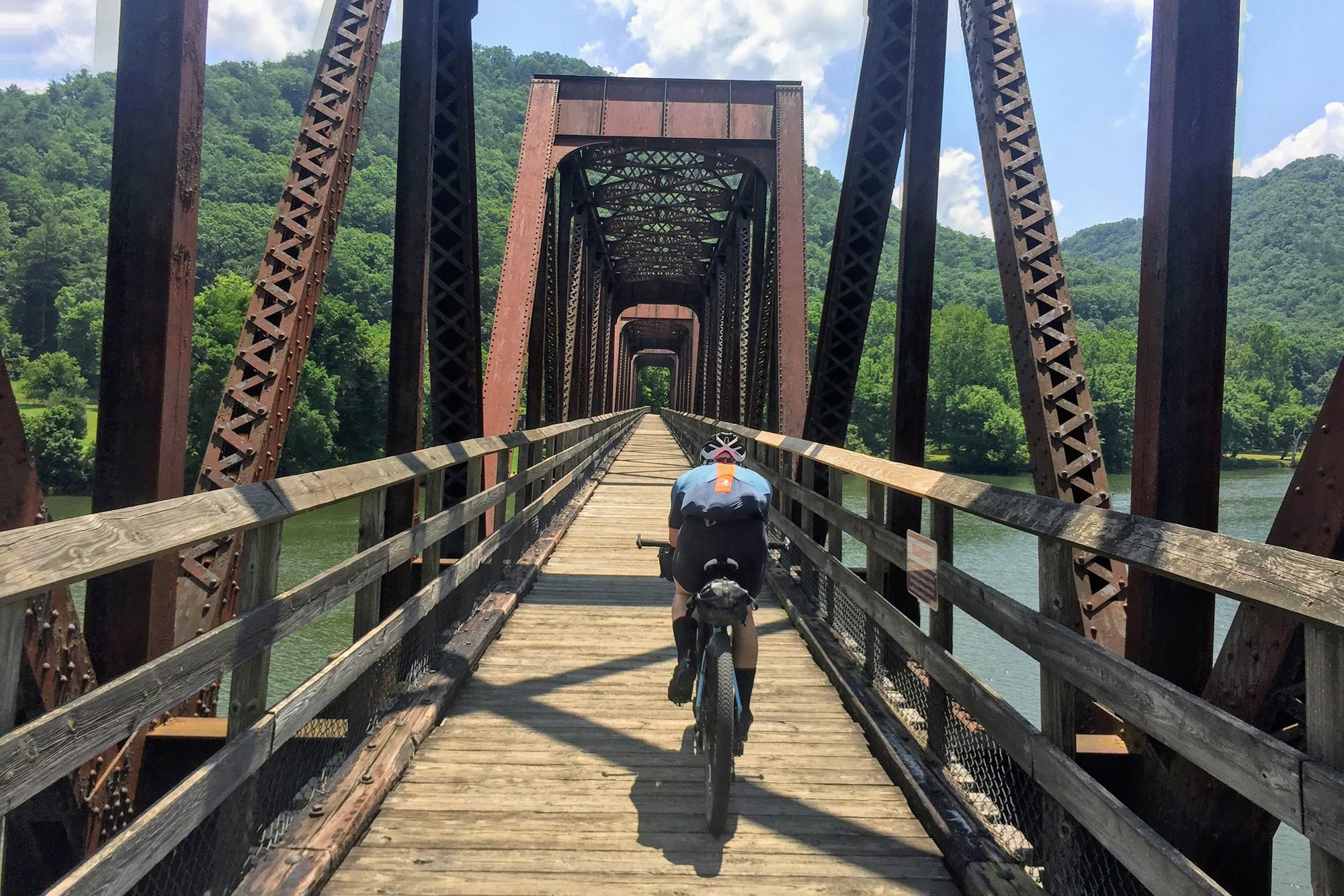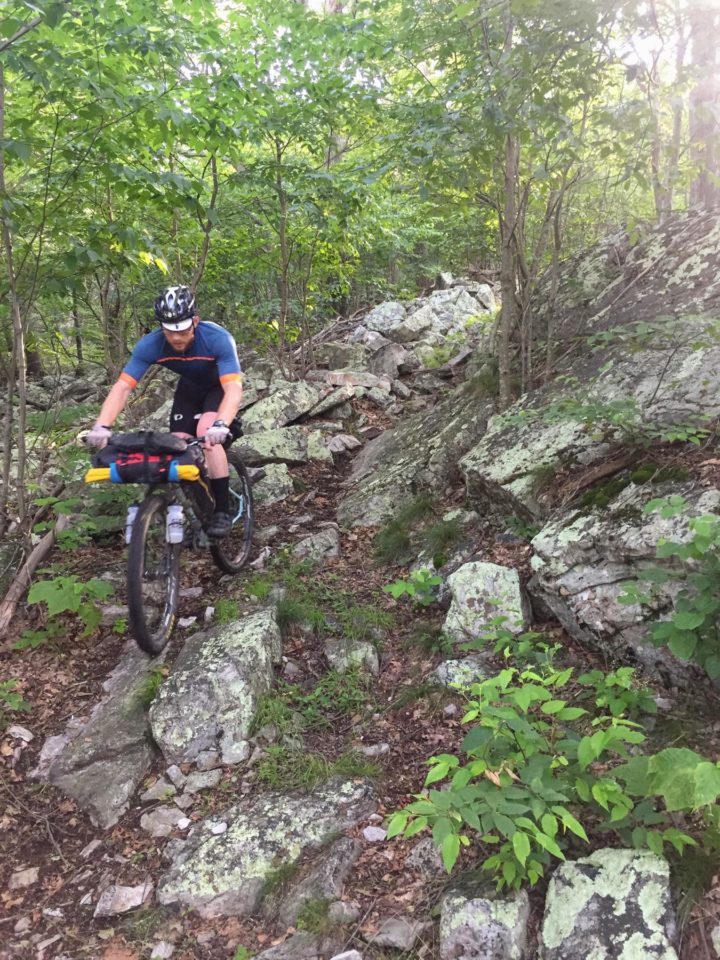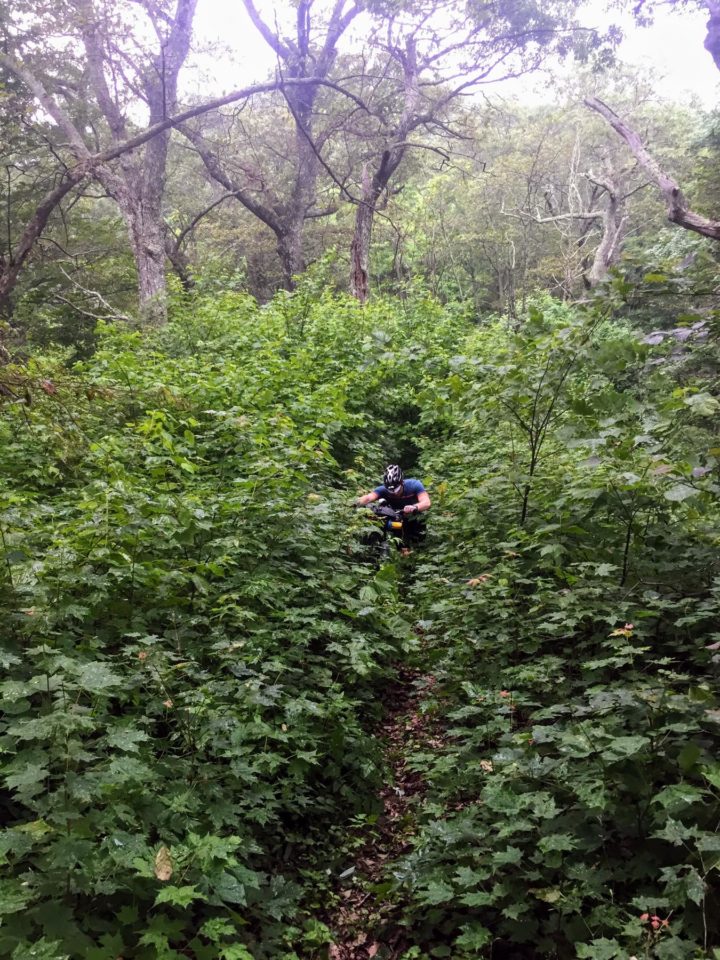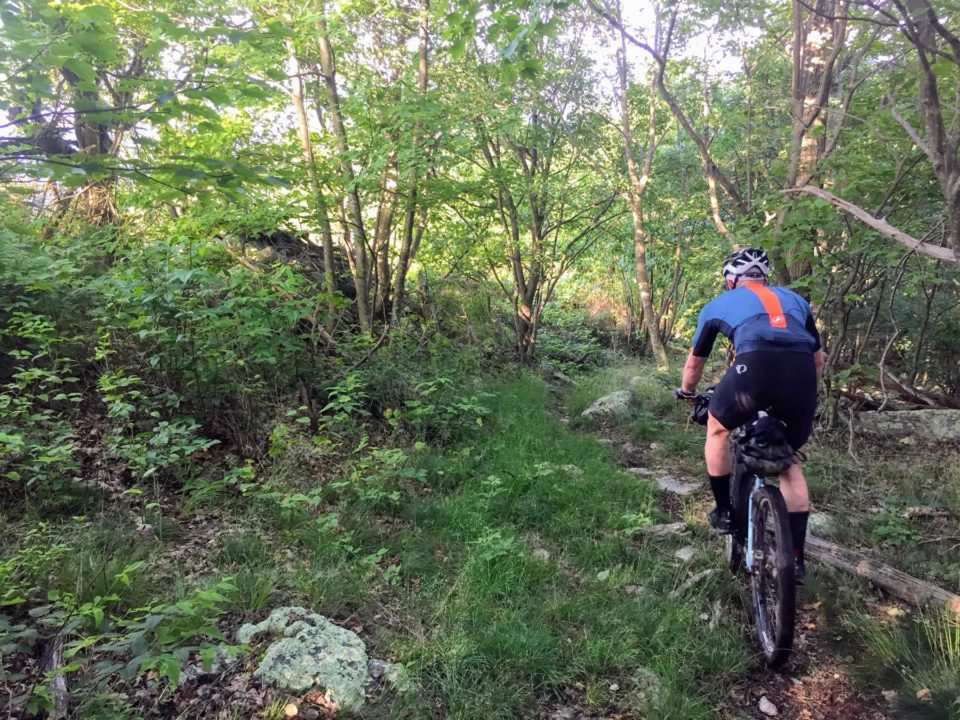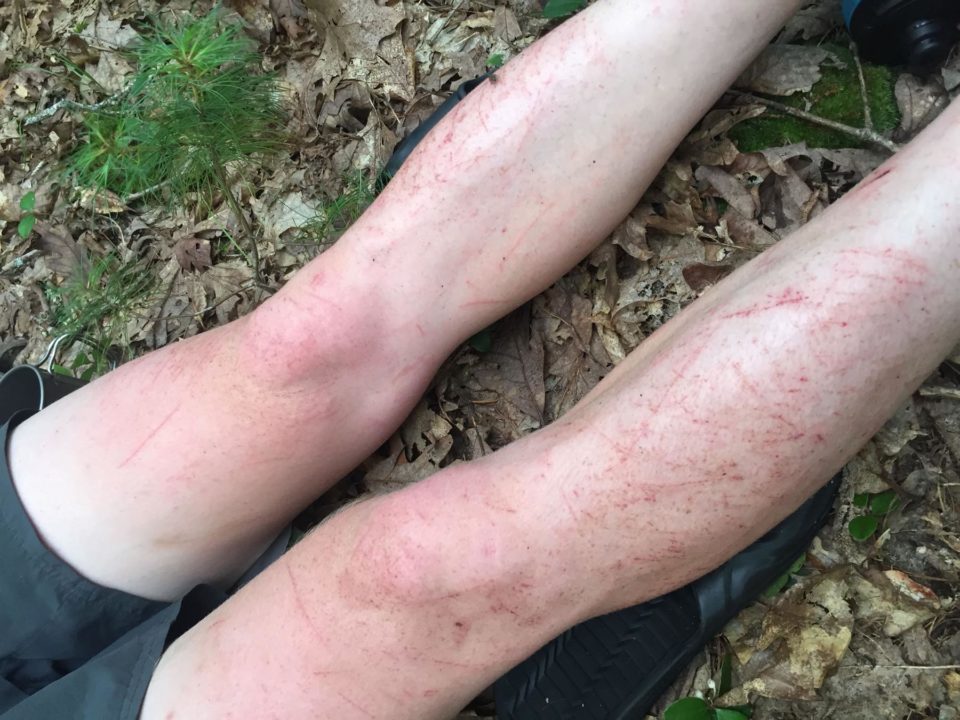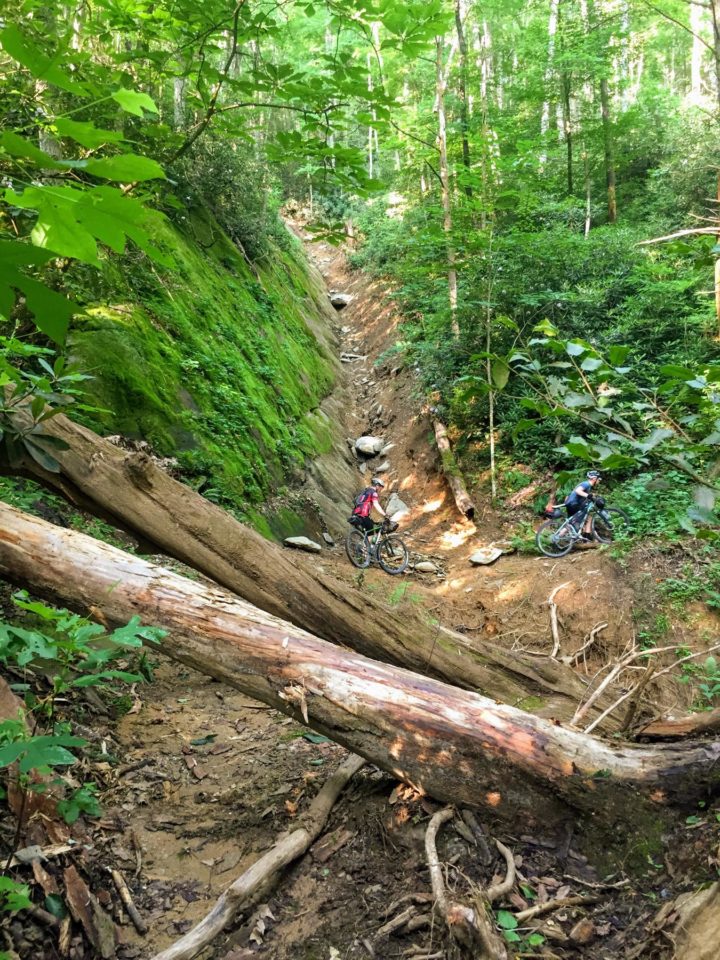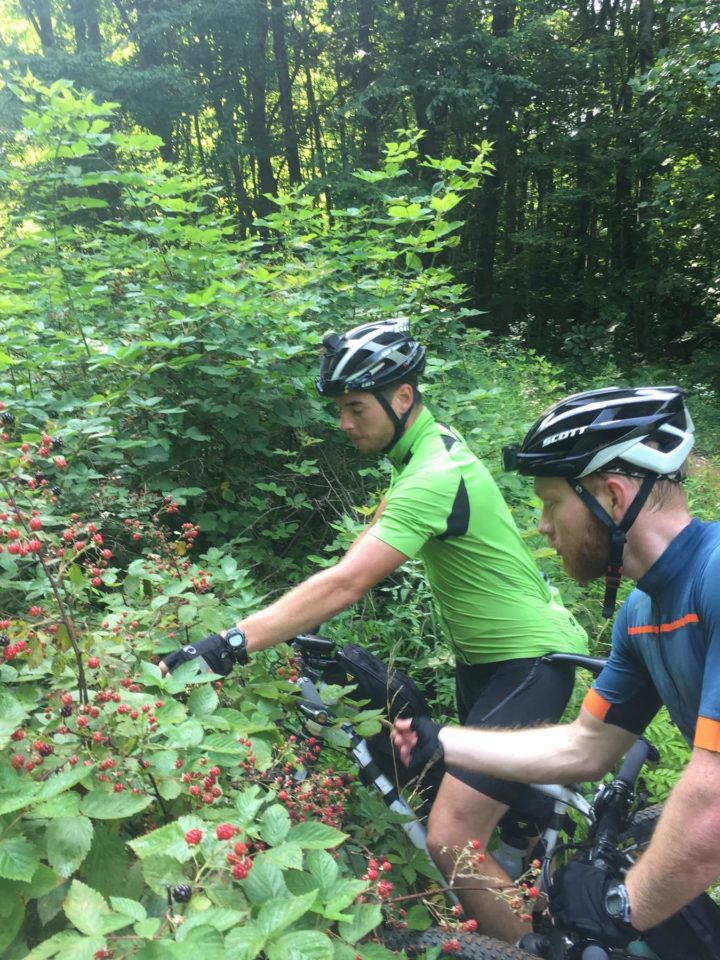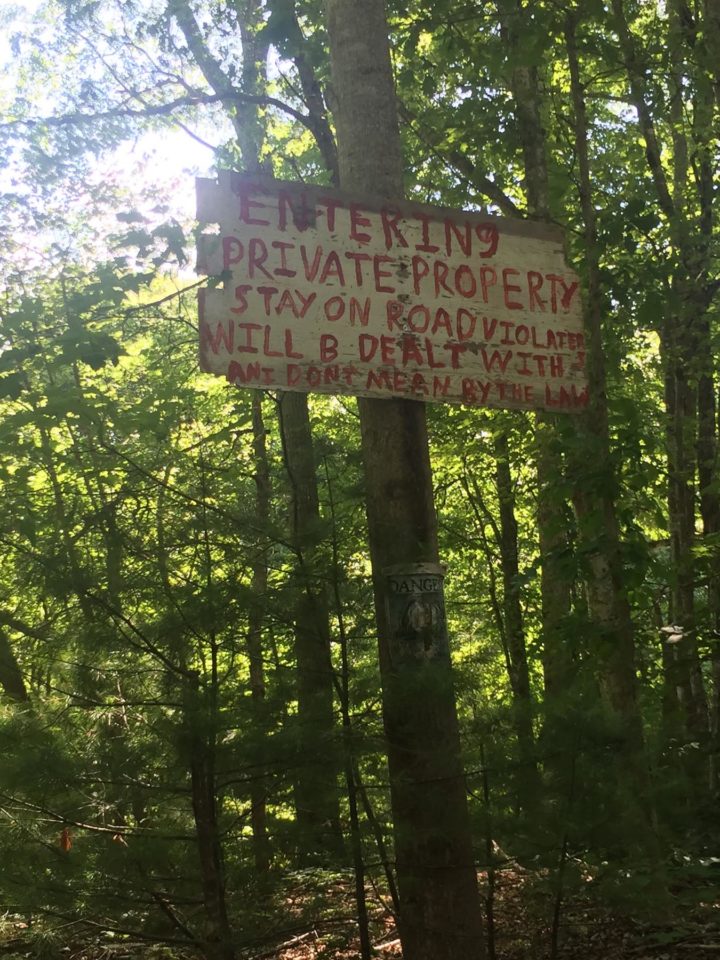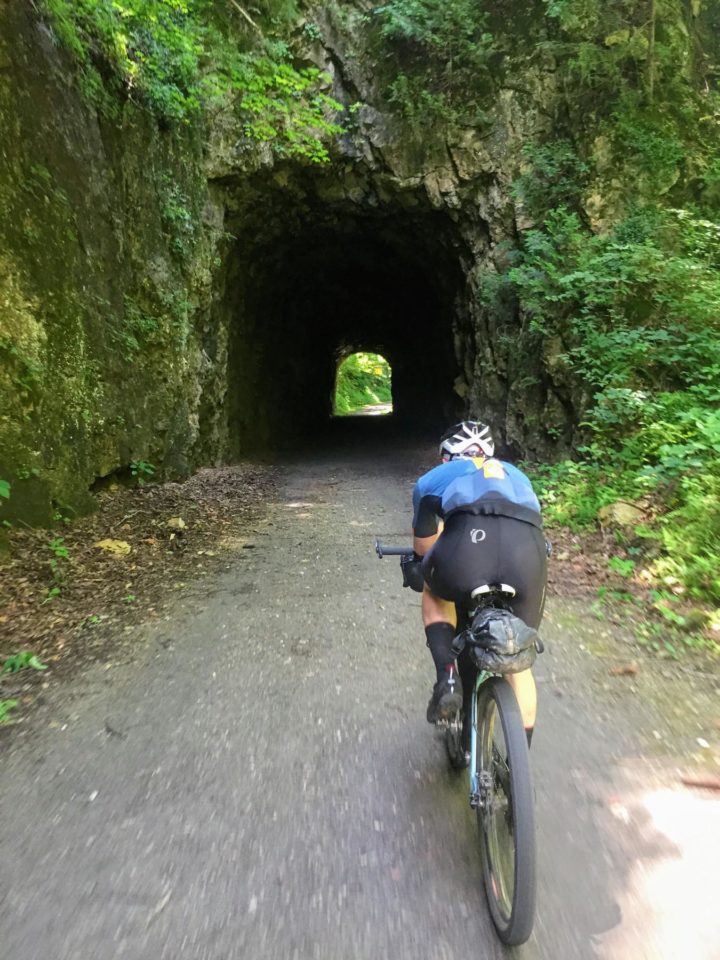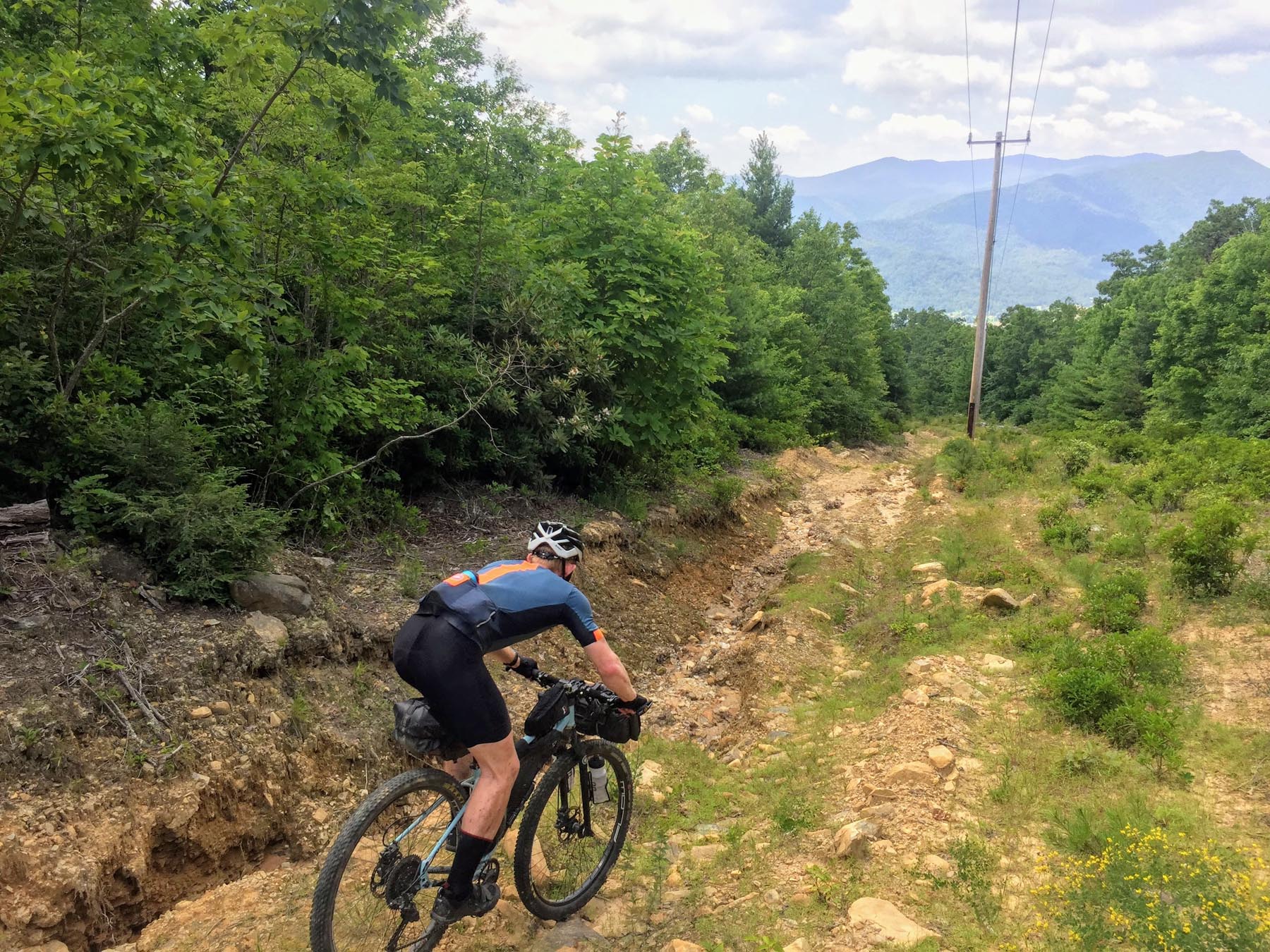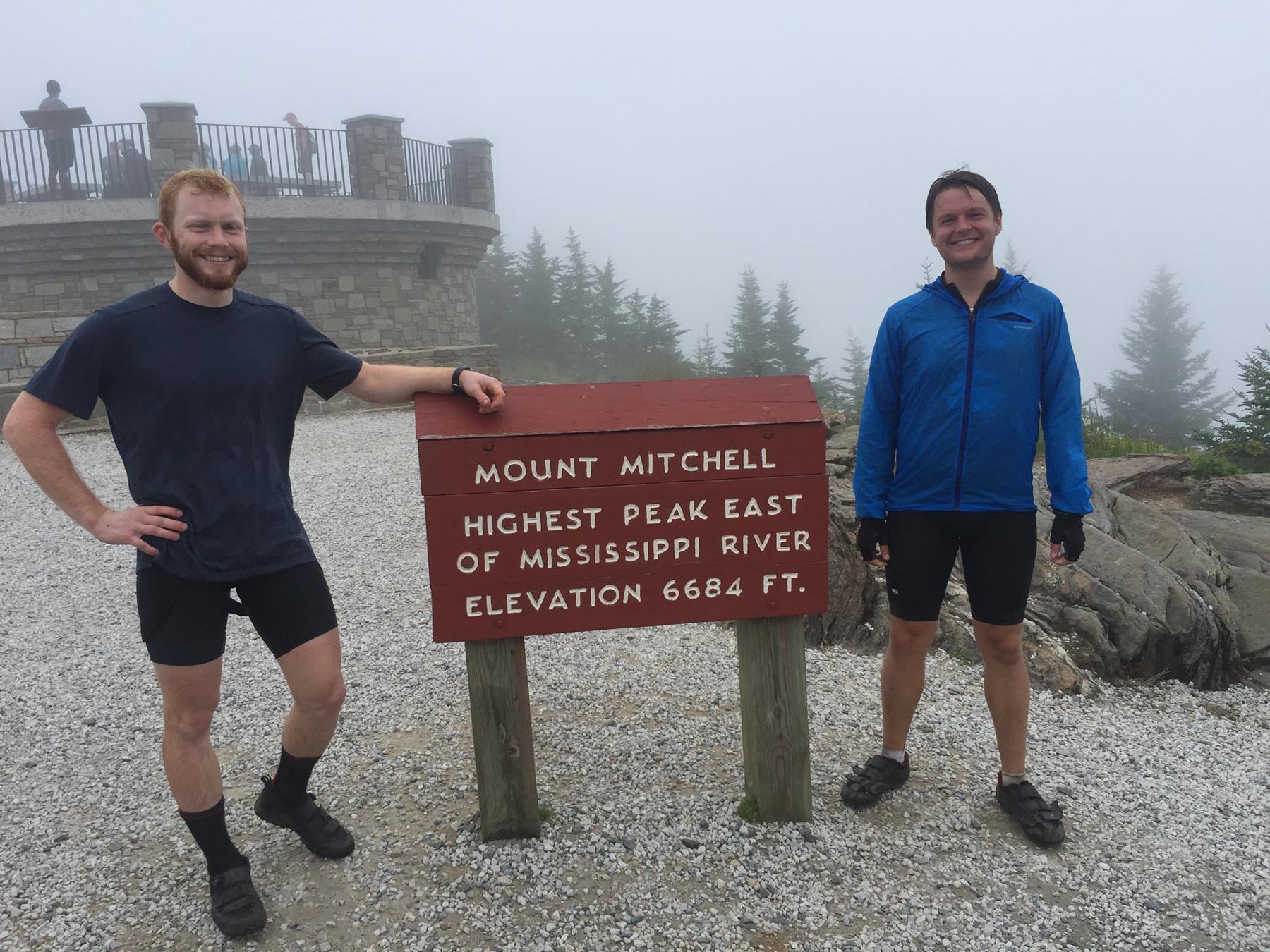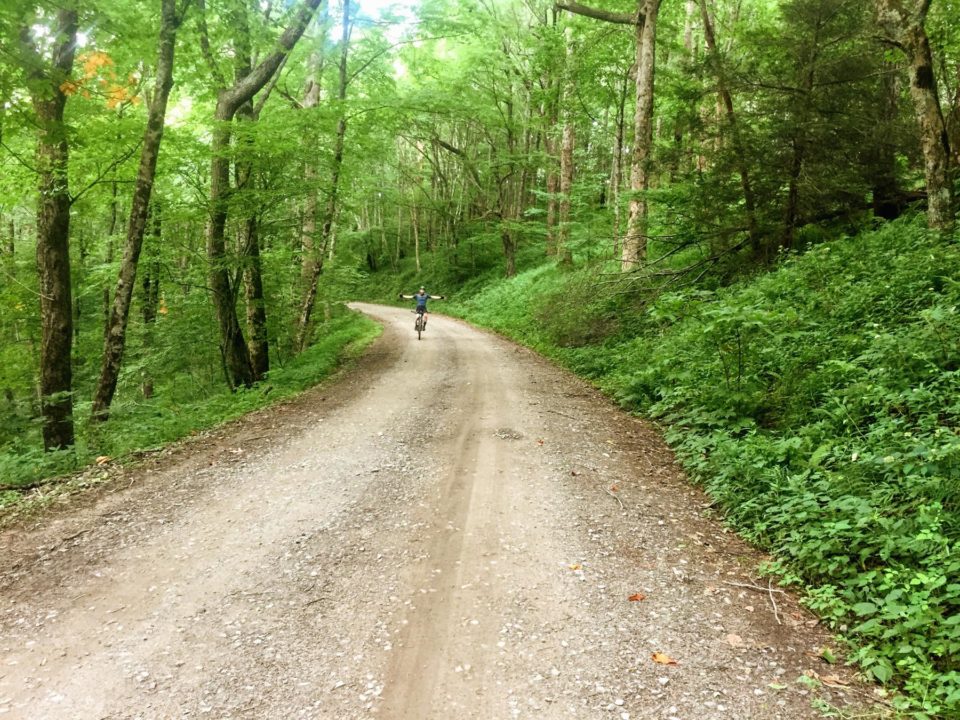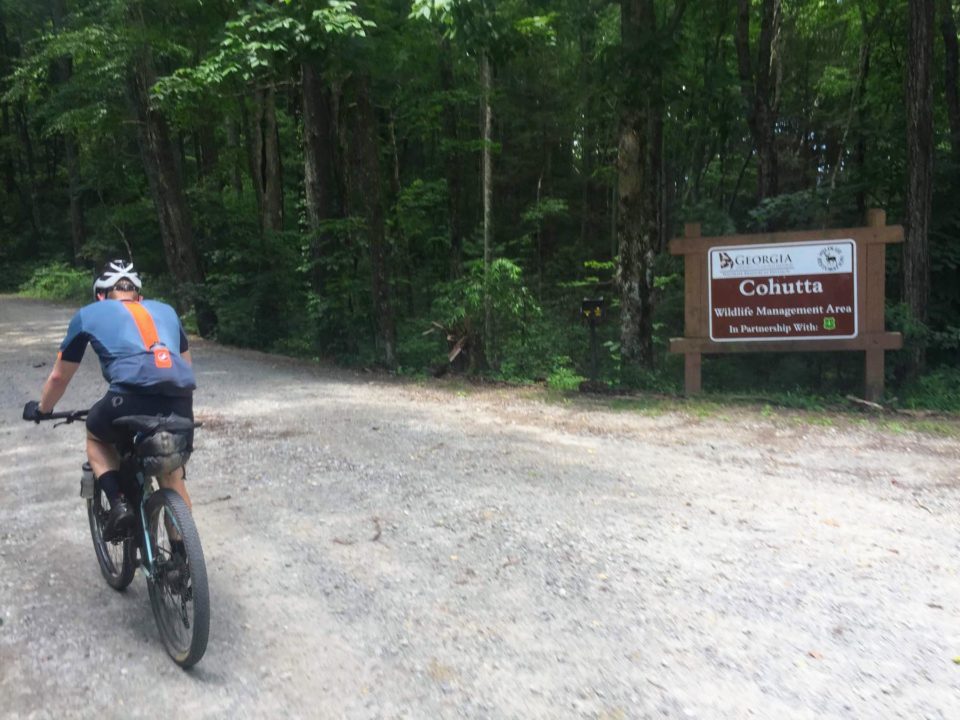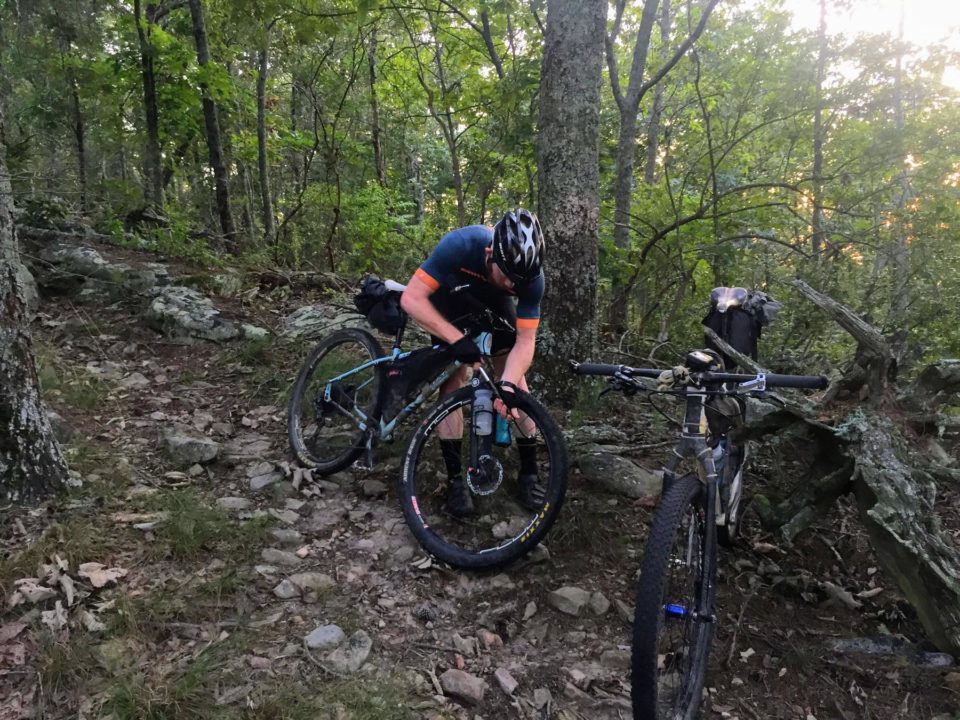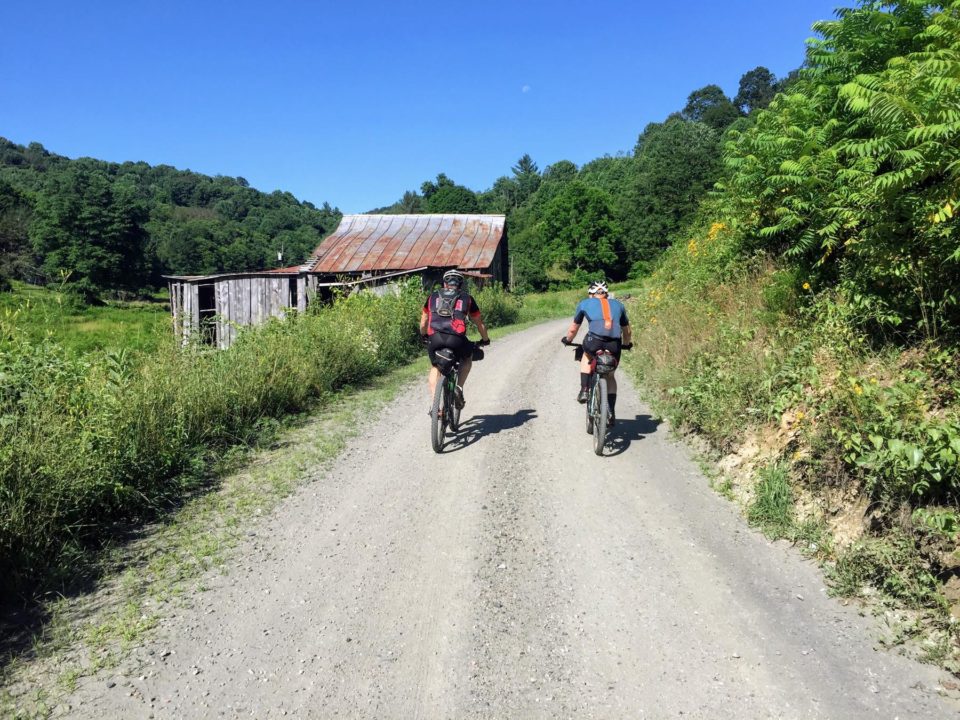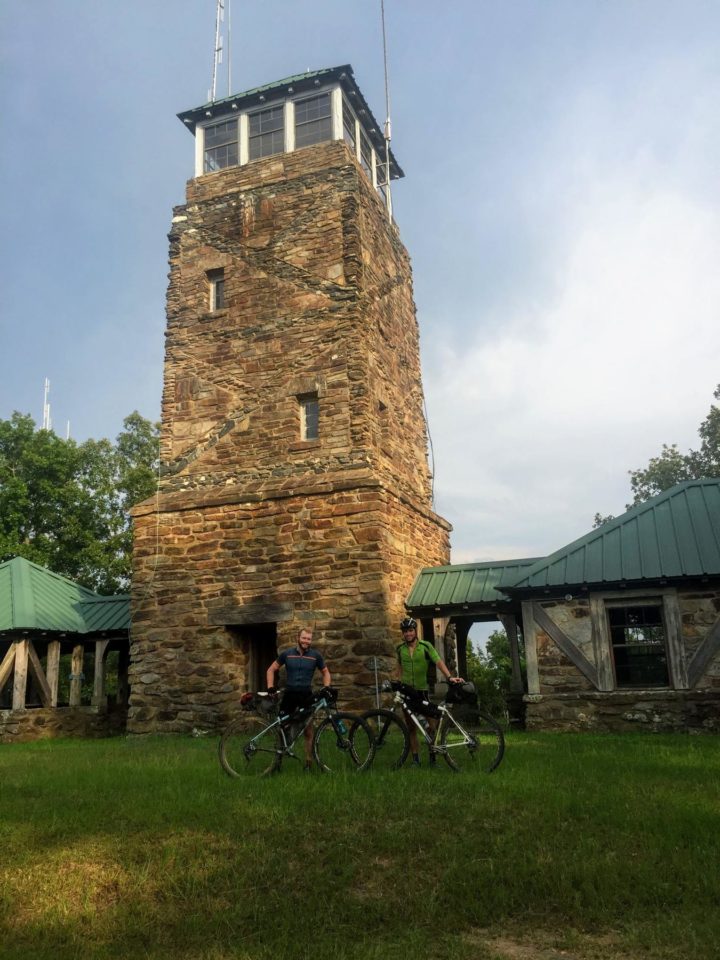Feast or Famine: First on The Southern Highlands Traverse
Ethan Burns and James Dunaway recently finished the 1,300-mile Southern Highlands Traverse, the longest and most arduous bikepacking route in the eastern United States. As far as we know, they are the first riders to complete a through-ride of the route in a single push. Here are some of their thoughts and stories from the trip…
PUBLISHED Oct 26, 2018
Words and photos by Ethan Burns and James Dunaway
Any section of the SHT, or SH(i)T as we came to affectionately call it, would be a worthwhile objective in its own right. The Virginia Mountain Bike Trail (VMT), with its hauntingly beautiful vistas and rugged ridges, has only been ridden in its entirety a handful of times. The Trans-WNC passes through some of the best singletrack and scenic roads on the East Coast. The Trans North Georgia (TNGA) route hosts what some consider to be among hardest ultra endurance races in the country. And the Alabama Skyway, well, it’s the Skyway, the classic multi-surface ride of the region.
Having grown up in the Southeast, the Southern Highland Traverse route seemed like the the perfect amalgamation of our cycling and adventuring passions. Ten months before our first pedal turn, we set a start date and began realizing how much we needed to learn. But we weren’t new to the idea of long, uncomfortable days in the saddle. James is a three-time finisher and one time winner of TNGA. We both raced 100+ mile endurance races in college, and I completed multiple 250-mile, 24-hour rides in Montana. But as we began planning, it became clear this would be a long-term investment unlike any we had previously attempted. There was gear to purchase, trails to ride, bikes to build, and a route to research. Not to mention lots of training to complete.
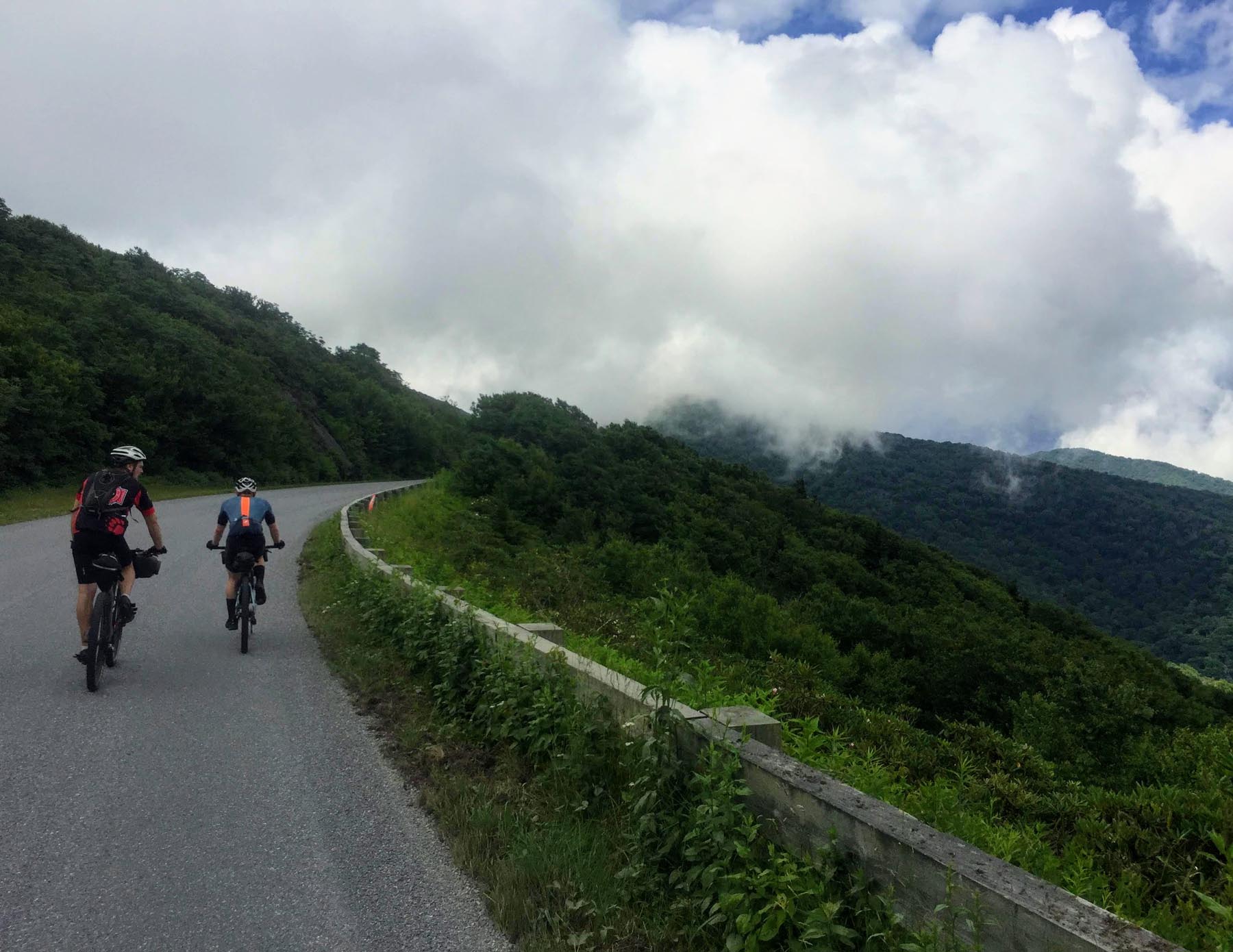
Early on, we broke everything down into manageable parts and began documenting all of our thoughts, training, research, and progress on shared Google Docs so we could keep track of each other’s progress. James, living in Chattanooga, TN, would be responsible for scouting Alabama and southern North Carolina. I would scout the VMBT, and eventually spend nearly every weekend between November and May making the drive west from DC to scout what were supposed to be the most rugged and unforgiving portions of the route. We decided to leave Georgia and much of Alabama alone. James knew TNGA like the back of his hand, and, perhaps foolishly, we felt Alabama would pose no real issue. Using great GPX files and route info published on this site, we slowly pieced the route together, taking detailed notes of where to find food and water, where camping opportunities existed, and how many miles we felt were possible per day.
This preparation gradually consumed more and more of our lives. James and I spoke on the phone several hours a week, and at the height of training logged 20 hours for every six-day period. The 10 months of preparation for our first big bikepacking trip were just as much a rollercoaster adventure as the feast or famine experience that capped off our summer.
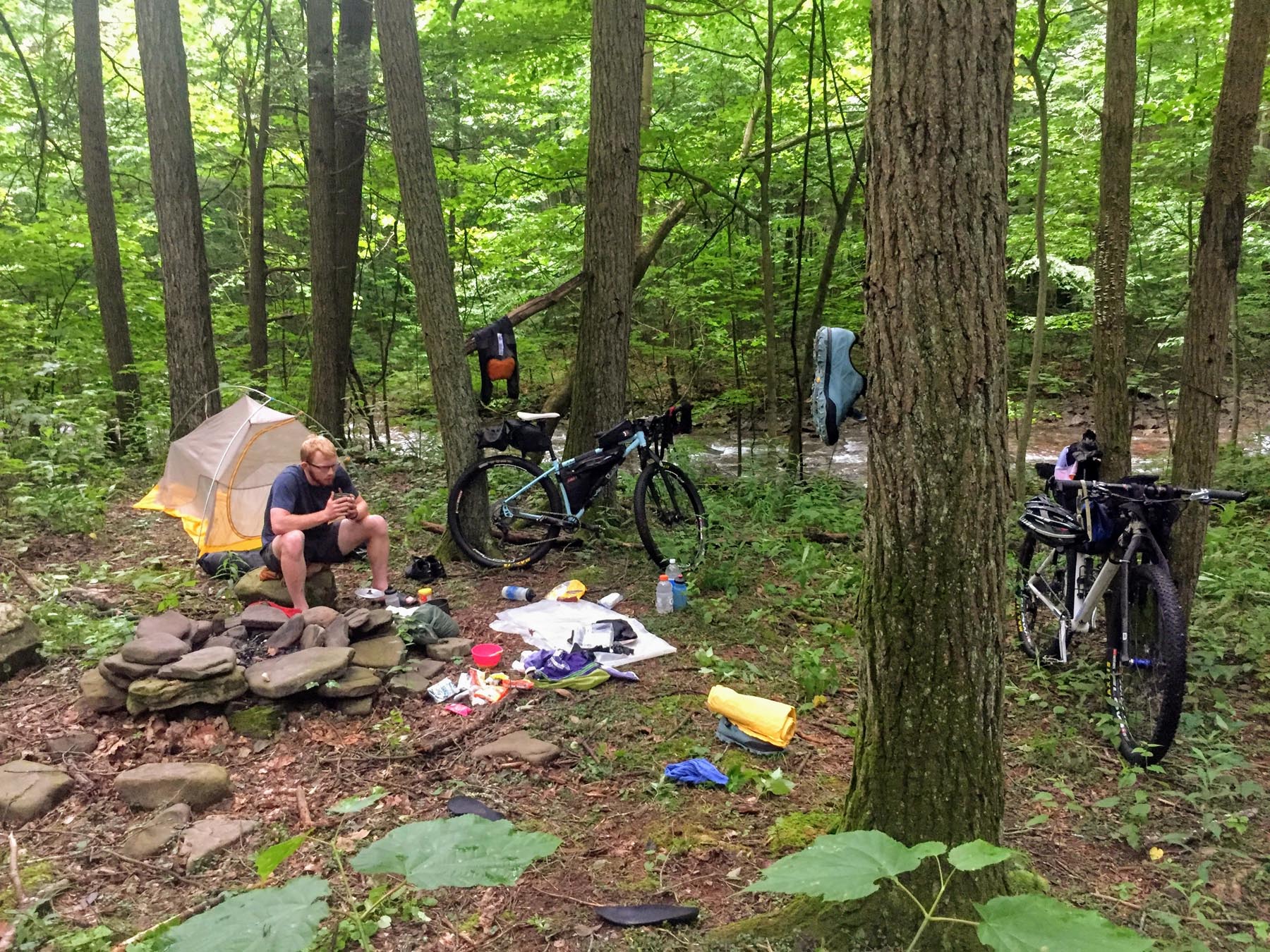
Hairy starts and early wake up calls
Virginia gave us, or at least me, an abrupt wake up call. As usual, James was in fine form, easily peddling up one ridge after another. He slung his bike over every downed tree and stream crossing as if his bags were empty. On the other hand, still recovering from a week of climbing in the Cascades just days before, I felt dehydrated and sluggish. I was worried. Only a day into our planned 17-day trip and all I wanted was 24 hours of rest and some time to acclimate to the humidity. Doubt and endless questions flickered through my mind. Were we really going to ride the Southern Highland Traverse in full summer heat? How quickly would my body adjust to this mercilessly thick air? Why the hell are my legs so heavy?
But when given no other option, the human body is quick to respond. Two days in, and 120 miles down, I found my legs and began settling into the pace. Working our way through the wet air, heavy fog seemed to swallow us at every turn. Only the occasional clack of rocks or click of dirty gears escaped beyond the gray buffer. During one of these extended periods of muffled grayouts, we startled the first of many young black bear cubs. Clinging precariously to a large oak the cubs looked down at us with expressions of tired irritation, similar to the one James would give me every morning as I rolled out of bed to go find the john. Long days of riding make me strangely regular, and by 5:30 I was up, no need for an alarm clock.
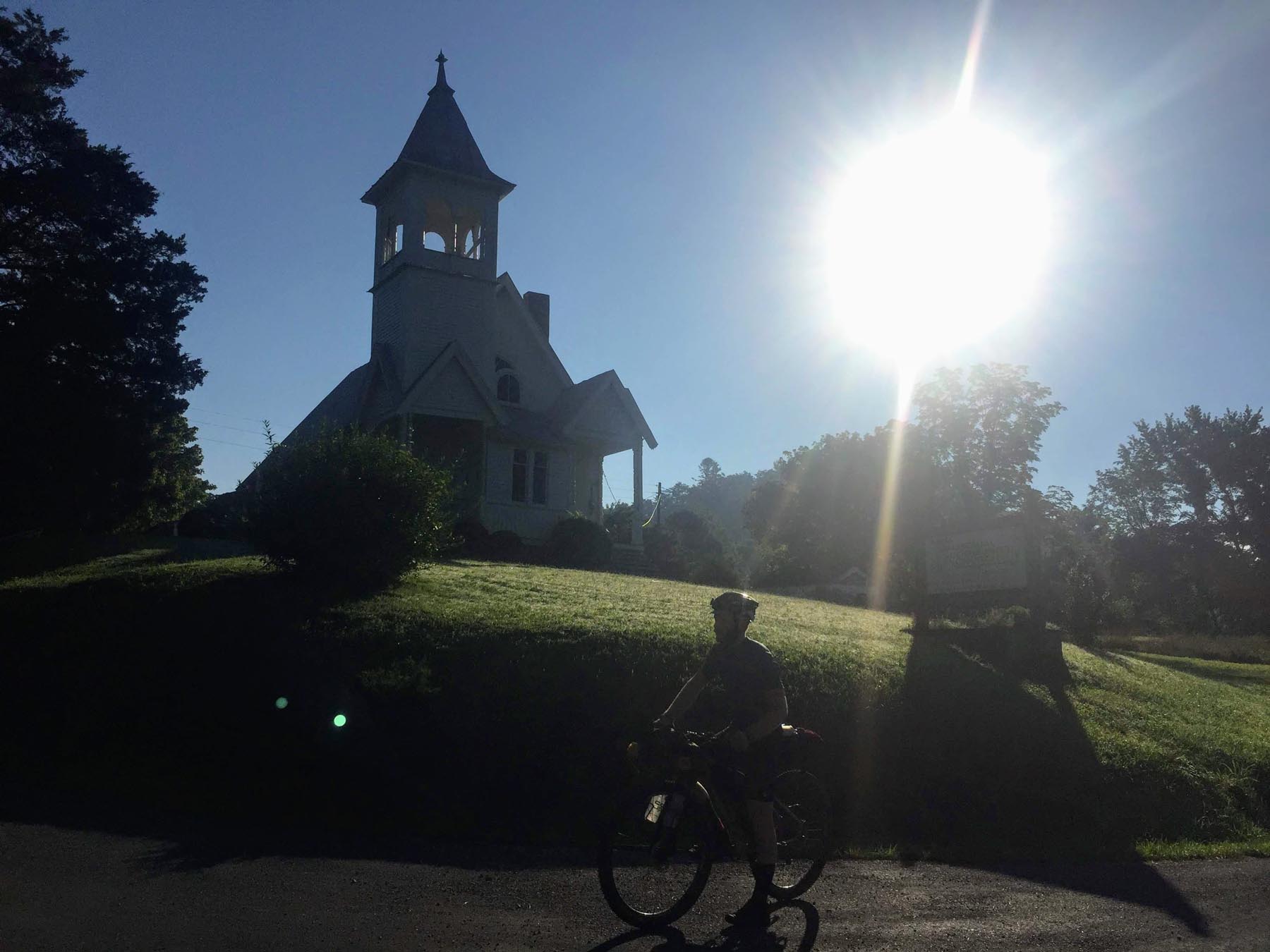
Day three found us starting a little earlier and groggier than usual. We’d bushwhacked for four hours along the ridge south of Reddish Knob the previous day, only to miss a small PVC pipe that was our only chance at getting water at that elevation. Unwilling to backtrack, we rode another 10 miles and headed off the ridge via an overgrown and wildly steep trail to find a creek in the valley below. Happy to have made the creek just as the sun was setting, we began our nightly ritual of soaking in a cold mountain creek and brewing up something hot.
The next morning, with our first real test fresh in our minds and legs, we were hoping for a few miles of easy valley riding. The map and elevation profile looked promising, suggesting a few miles of relative flatness before heading up our first climb of the day. Fortified with this knowledge, we rolled out of camp and headed down a fairly rideable trail. Just as I was sliding into the mental space I enhabit when James and I can’t ride side by side, a yell of frustration and a series of curses broke the quiet. Our flat trail, winding its way through rich floodplain soil, had suddenly entered a seemingly endless and unavoidable thicket of stinging nettle. The small, torturous hairs on the stems and leaves of this unassuming plant worked their way into every nook and cranny of our bibs and left a tormenting sting that would continue to plague us for weeks to come.
Playing the Wrapper Game
In a literal sense, the food situation along the SHT is what gives the route its feast or famine nature. Like any bikepacking route, SHT riders can expect their fair share of gas station dinners followed by oatmeal breakfasts. Starting in Virginia, the route travels through some of the most rural regions of Appalachia, and for several days it offers nothing more than a Dollar General if you are lucky. Often times, bikepacking routes do their best to stay on backroads and avoid urban areas or major highway intersections, but there is always comfort knowing that resources are reachable every few hours if one is willing to deviate off route. This is not the case in the first four days of Virginia; you’re out there and you better be prepared for whatever the trail throws at you. Fortunately, we were expecting this extreme and knew where to find the few stores close to the route. As it happened, we never had to go more than 30 hours without a resupply in the first five days. With one gas station stop after another in Virginia, we did our best to put a dent on the wrapper industry. As we grew accustomed to our new diet, there were several staples we could count on at every resupply, most notably the Pop-Tart, but we usually experimented with our fuel by testing out the full gas station inventory. If anything, it gave us something to laugh about. Occasionally, we stumbled upon some peanut butter, which was the ultimate game changer in our nutrition for the following 20-30 hours. After walking up to the cashier with pounds of junk, it became our standard practice to ask to borrow their phone, as that was our only way of communicating with family. Our phones rarely had any service in Virginia and we were jealously guarding battery life. Needless to say, we received several strange looks.
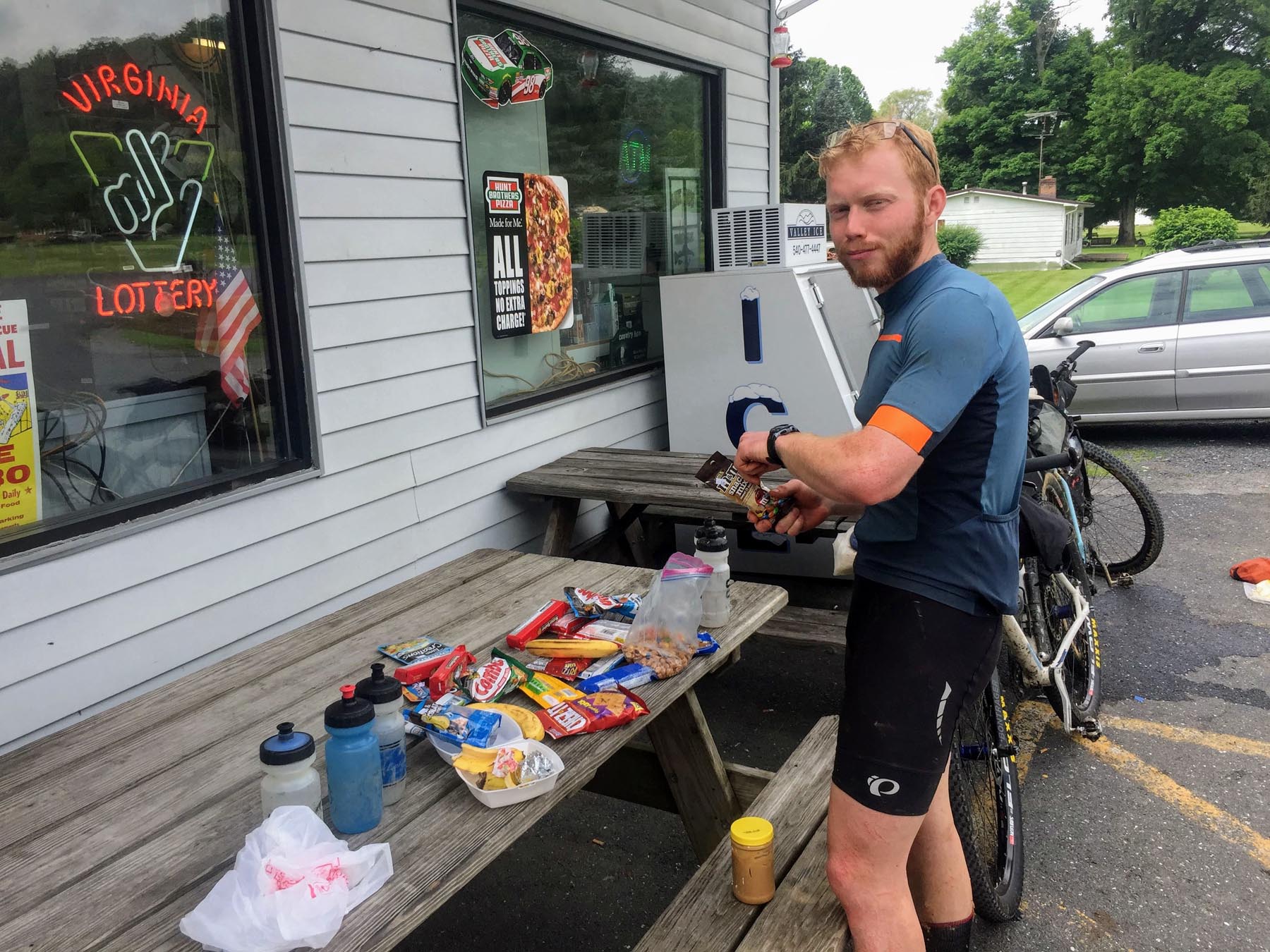
Wrappers are the name of the game for a majority of Virginia, but after finishing the VMT on the ridiculous 20 mile Iron Mountain Trail, things take a major turn for the better. Marking the beginning of the North Carolina segment, Damascus is a quaint little mountain town nestled at the base of southern Virginia’s Grayson Highlands. This beautiful getaway was the perfect place to spend the most monumental evening of our trip. Damascus sits right along the Appalachian Trail, so it offers several locally owned restaurants, outdoor stores, and hostels, all of which are within walking distance of one another.
We parked our bikes at Woodchuck’s Hostel and for $20 each we had our own cabin along with a full breakfast prepared by Woodchuck himself. But things only get better from Damascus, and within a few hours of leaving we found ourselves passing through the hip college town of Boone, shortly followed by the picturesque mountain town of Blowing Rock where we stayed the night with family and enjoyed some local food.
North Carolina’s central segment contains many notable features, but the the traverse around Linville Gorge and the climb up the Mount Mitchell Ridge stand out among the climbs. Technically, the SHT bypasses the three-mile state highway to the summit of Mt. Mitchell, but having come so far we couldn’t pass up the opportunity to stand on the top of the East Coast. Unfortunately, our enthusiasm wasn’t rewarded. The summit was cloaked in a now familiar surrounding of cold, wet fog. Regardless, our spirits were high. After a quick breakfast and many warm cups of coffee at the Mt. Mitchell St. Park Restaurant, we turned our minds to the Blue Ridge Parkway and its 30-mile descent into Asheville.
Without a doubt, Asheville, NC, was the anomaly of our trip, and the perfect place to spend an afternoon off. We were surrounded by buildings, grocery stores, bike shops, and countless local breweries and restaurants. We splurged like no other, and made the best with our short time off in the city while grappling with the fact that we were only at the halfway point of the route.
Leaving Asheville, we felt like we were long overdue for some off-the-grid suffering, but North Carolina just kept on providing. A beer at Oskar Blues Brewery in Brevard the following day hit the spot after some amazing Pisgah singletrack, and we were now within striking distance of Georgia. We had one last good meal in the lavish mountain town of Cashiers in southern North Carolina. At this point, we knew the luxury was over, and for the most part we were back to a wrapper diet until this finish.
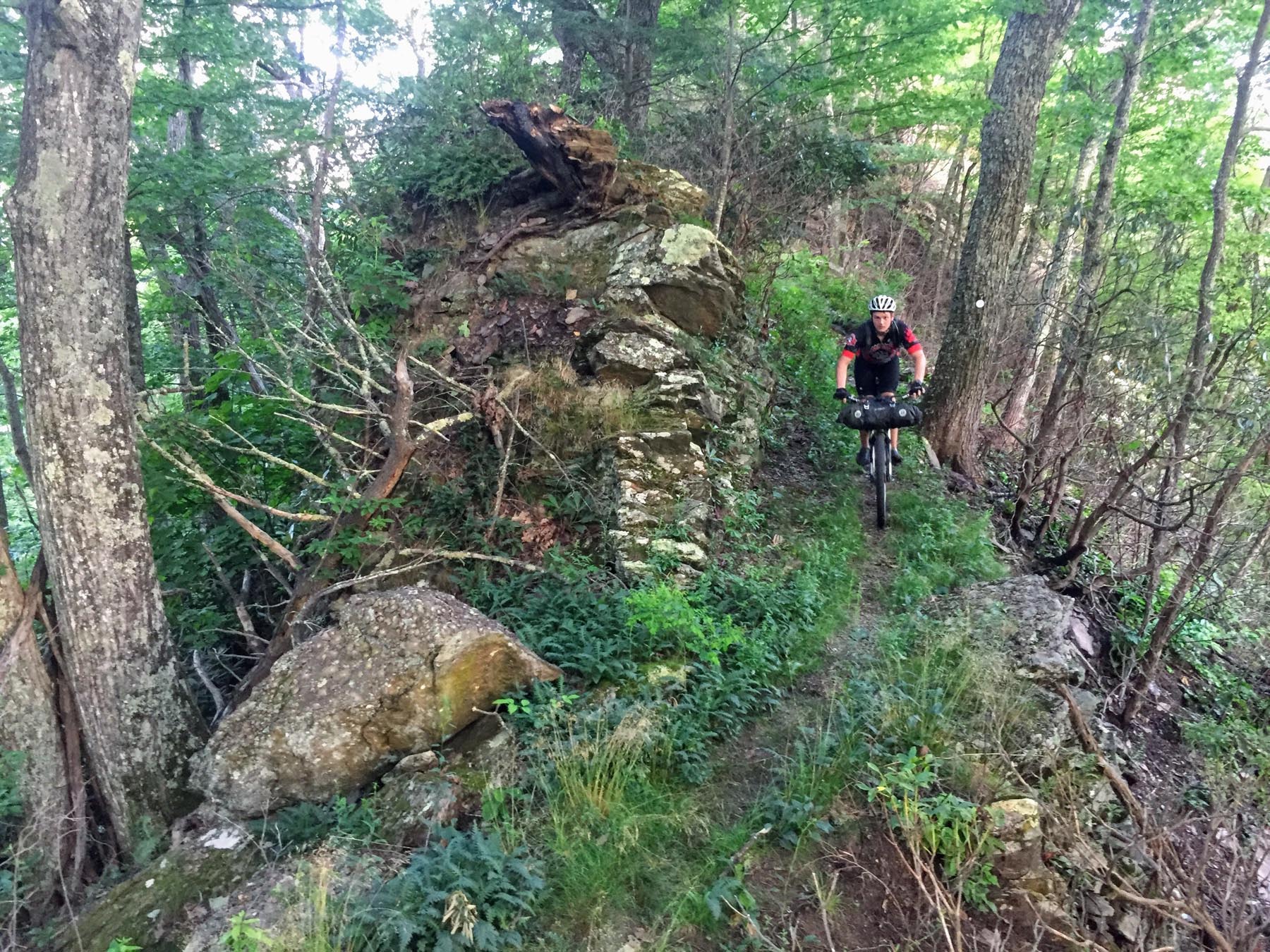
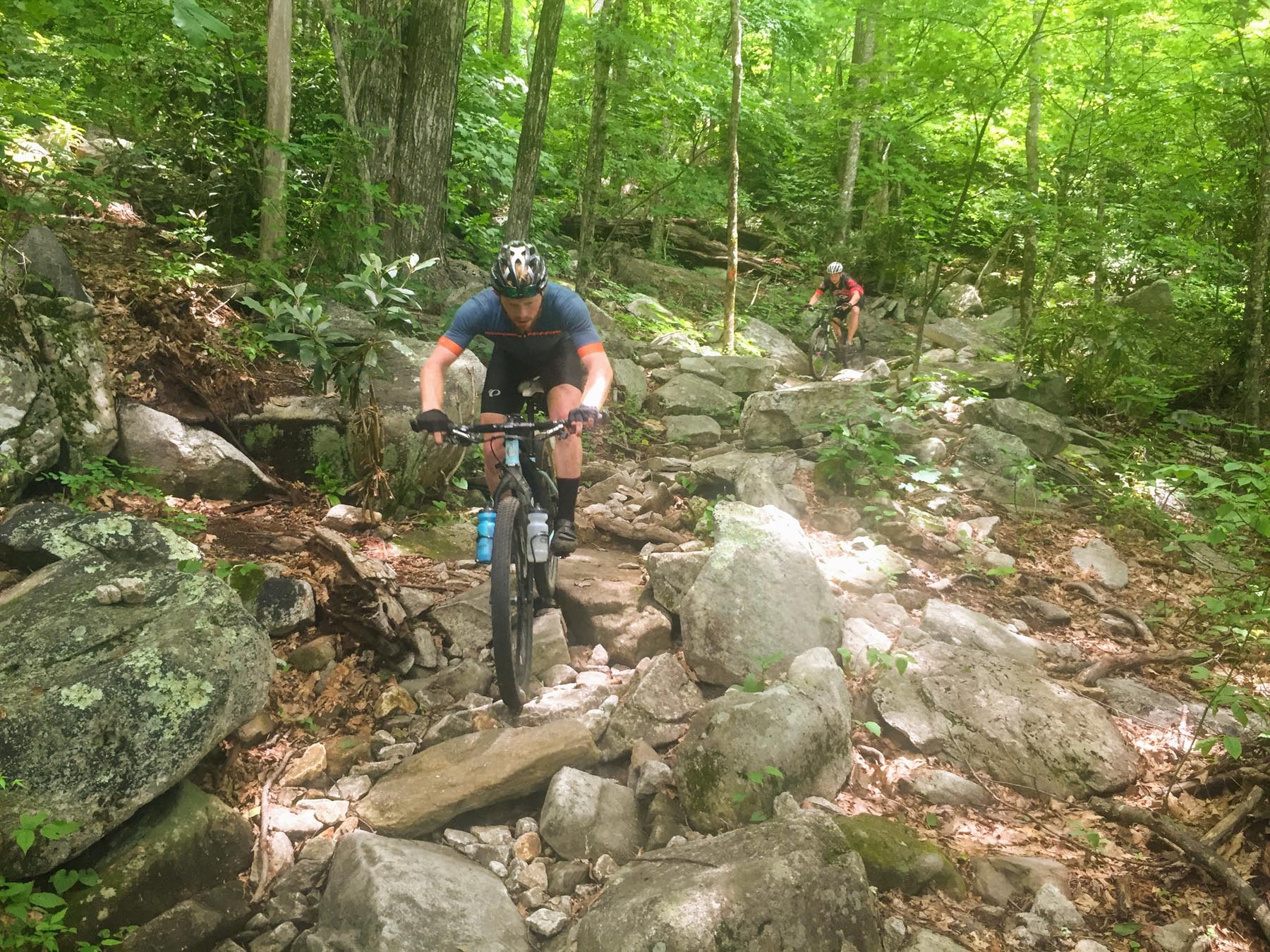
Pinhoti Roller Coaster
No section of the route better embodies the feast or famine nature of the SHT than Georgia’s Pinhoti trail. Starting outside of Blue Ridge, the trail continues some 340 miles to central Alabama at the trail’s southern terminus at Flagg Mountain. The last quarter of the SHT essentially follows the Pinhoti, or closely parallels the Pinhoti, so the trail’s notorious turkey foot blaze becomes a holy and reassuring symbol when you are lucky enough to spot one along the overgrown and seldomly maintained trail.
The term “trail” is an ambitious description of the Pinhoti, especially the Georgia sections. In some regions, the Pinhoti consists of world-class mountain bike singletrack, whereas in others it is an overgrown ridge path at best, full of briars, branches, and rocks, making it impossible to carry any speed or rhythm. Bizarrely, many sections of the route follow state highways, some of which have four or more lanes and are in no way desirable to any cyclist. But that is the nature of the Pinhoti, and also of the SHT: it doesn’t make sense because it’s not supposed to. This is largely because like the SHT route, the Pinhoti was developed and is maintained by people of various backgrounds and interests. These differences become very obvious and almost comical when combined into one giant bike ride where it is easy to compare sections of the route.
Starting just west of Blue Ridge, Georgia, we hit the northeastern terminus of the Pinhoti around midday. The combination of the incredible singletrack this area offers and the accommodations provided at the Mulberry Gap Mountain Bike Get-A-Way, make this one of the premier mountain bike locations on the East Coast. Flowy trail was a nice change from our previous few days of grinding up and down gravel mountain roads.
We had our eyes and appetites locked in on Mulberry Gap’s kitchen for an entire 24-hour period, as it meant the end of a 115-mile food desert after stopping at a gas station in Helen the prior evening. Fortunately, we didn’t run out of food until we were about 10 miles from Mulberry, and at this point the thought of a real meal was more than enough to keep us going. The service and BBQ dinner we received at Mulberry during one of their few off-afternoons was nothing short of amazing, and definitely helped bring our spirits and minds back after the distance and elevation we had just covered in 48 hours. We camped close by so we could have an easy ride on the Pinhoti to Dalton the following day, where we planned to take an afternoon off, sleep in a hotel, and give our legs and minds some much needed rest before our final 230-mile push.
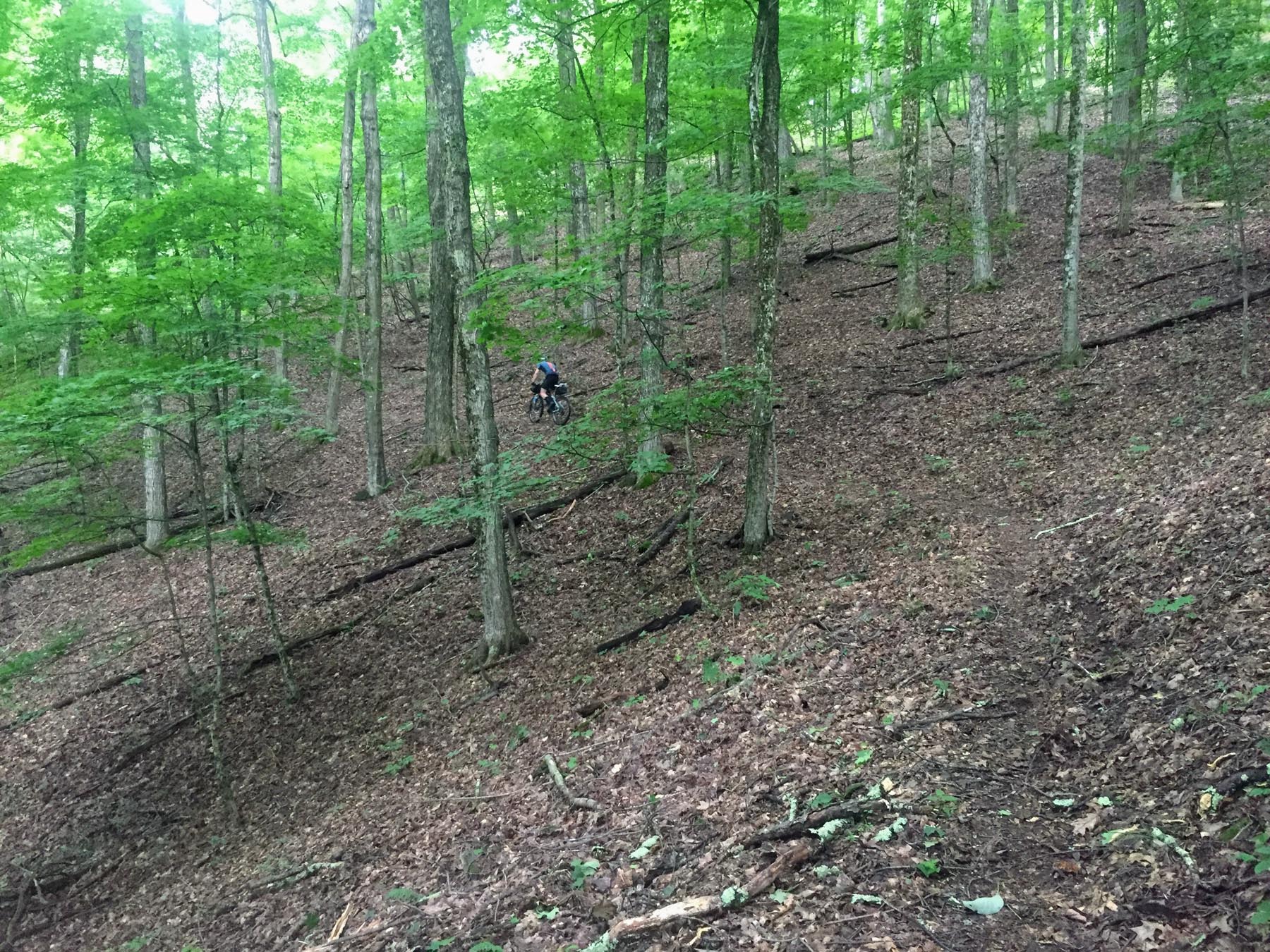
Our 4:00 am wake up call brought the dreamy world of hotel beds and endless food to an abrupt end. Rubbing 10 hours of sleep from our eyes and trying to ignore the upcoming 48 hours until our planned finish date, we loaded our pockets with McDonalds and climbed out of Dalton. By 5:30 am we were on the infamous Snake section of the Pinhoti. This winding, ridge-running section of trail marks the real transition from the flowy Pinhoti near Mulberry Gap to super technical, old-school riding. The miles were slow, but we were moving at a steady pace until about 1:00 pm that afternoon. By then, we were so far from any urban area that the trail received little to no use or maintenance. In northwest Georgia in July, that means an overgrown jungle of blackberry, greenbriar, and an assortment of fast growing shrubbery. To complicate things, there was also an unusual amount of branches and downfall on the trail. We later learned that 2018 had been an unusually windy year. By now, the miles were slowly crawling by, it was hot as hell, and we were losing water at an alarming rate. Most creeks in northwest Georgia are nasty, bathwater-warm roadkill creeks, and not exactly inviting to drink from. I’ve ridden this trail many times and knew dehydration was just the nature of the beast unless you want to carry 10 pounds of water, but trail conditions were slowing our pace and by 3:00 pm we were beginning to worry. Progress seemed impossible. Finally, after a severely bent derailleur and multiple flats, we arrived at a gas station outside of Rome. It was our first resupply in 13 hours and we were completely wasted. Behind schedule, we tried not to think about the 70 miles we needed that day to stay on track with our goal.
We knew we were about 30 miles from the Alabama border and found some comfort knowing it would all be on asphalt. Or at least that’s what we thought. Not minutes after turning on our lights south of Cave Springs, the GPS directed us into some recently-logged pine forests. Confused and angry, I was certain the GPS was broken. But not doing your homework is never smart, and it turns out the Pinhoti found yet another way to trick us.
An Alabama Crawl
After a 16 hour day to end the TNGA, we woke up at 4:00 am just over the Alabama line and rode to some fast-paced internal metronome. Our petals turned over in a breathless cadence, one too quick to take in the roadside scenery or notice the ripening blackberries. Only the briars caught our attention now, and only fleetingly, as we rushed on, chasing the patch of light our headlights threw in the predawn cool.
The first 50 miles flew by as the sun climbed above the horizon. I’ve always taken notice of how quickly those dawn hours move, as if the sun and time itself are in a race for noon. Both scream into the new day, ticking away degrees as they shoot around the earth and the clock face. Yet, having made it to the top, neither seem in a hurry to leave. Our final shadeless hours crept by.
Red, rolling hills, each like the last, lent an unwelcome heat to the Alabama monotony. Our already heavy legs struggled to cut the still air. For days we had been dreaming of Alabama’s flat elevation profile. Only a handful of real climbs and we would be home free. We dreamt about long stretches of open roads, of easy speed. Just days before, we had bullishly hoped lightened hearts, flush with success, would lend power to tired legs. The last 120 miles would be a breeze, we figured. If only the smallest of gusts had wandered through the pines.
The jaring reality of endless gravel nearly stopped our forward progress. Water bottle cages, worn by 1,200 miles of vibration, broke at the welds. Tire casings split, spaying sealant and dreams of an early finish into the ditch. Our speed and forward momentum seemed inversely related to the now languid rise of the sun and the slowing tick of the clock.
With 25 miles to go, we found a small creek and crawled into it. Filling bottles, I vaguely wondered if the metallic taste was from the water or the oily slick of sweat and sunscreen snaking down stream. It didn’t matter. Twenty minutes later James voiced my thoughts. Responding with a small smile, I climbed back to the road above. Metallic water or not, James looked a little more alert, my back was cool, and the hill ahead seemed a little shorter. Riding now at a less hurried pace, we nodded to an old blue Ford. The driver raised a beer in our direction and disappeared around the bend. No single gesture seemed more appropriate as we we slowly ground out the remaining miles on our way up a long-forgotten corner of the Appalachians.
After what felt like eternity, we made the last punchy climb up Flagg Mountain to a beautiful stone CCC tower. Preserved in stellar condition, its silent presence began to give some sense of meaning to our journey. From Virginia to Alabama, up one rutted and rocky road or forgotten trail after another, we were given the privilege to see countless hidden gems of our own backyard. From a sluggish and foggy sunrise on Mt. Mitchell, to world-class singletrack in Brevard and double IPAs in Virginia, the SHT gave us a truly authentic Southern slog.
By the numbers
- 1,292 miles
- 17 days
- Daily Average: 76 miles
- 1 off day, 2 off afternoons
- 153,391 feet of elevation gain
- Longest day (moving time): Day 16: 13 hours
- Longest day (distance): Day 17: 118 miles
- Longest day (elevation): Day 13: 14,000’
- 21 bears
- 3 other mountain bikers
- 3 bike shops
- 5 flats
- 1 broken derailleur hanger
- 2 bent derailleurs
- 2 chains each
- 4 brake pads
- 1 replaced bottom bracket
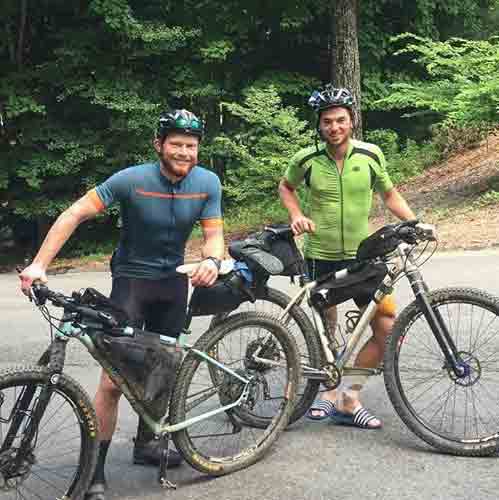
About Ethan and James
Having met racing bikes in college, James Dunaway and Ethan Burns fell in love with endurance racing and extended adventures of all kinds. Now each new summer brings an excuse for the two to tackle another trip, and a chance to reunite around a shared love of two wheels and a desire to move fast and far.
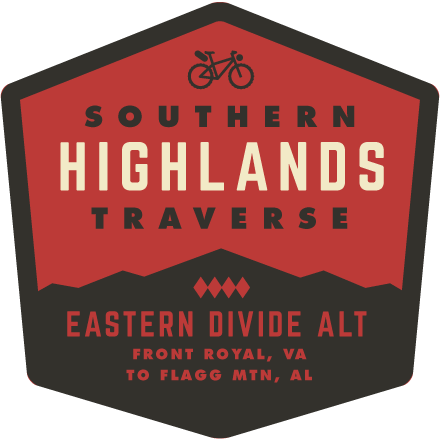 The Southern Highlands Traverse is the fist long distance bikepacking route on the east coast starting in Front Royal, Virginia and finishing at Flagg Mountain, Alabama, at the southern terminus of the Pinhoti Trail. The route traverses a mix of over 1,200 miles of gravel roads, forest doubletrack and plenty of the South’s most challenging singletrack. The Southern Highlands Traverse will also serve as a challenging single track alternate in the forthcoming Eastern Divide Trail. Learn more here.
The Southern Highlands Traverse is the fist long distance bikepacking route on the east coast starting in Front Royal, Virginia and finishing at Flagg Mountain, Alabama, at the southern terminus of the Pinhoti Trail. The route traverses a mix of over 1,200 miles of gravel roads, forest doubletrack and plenty of the South’s most challenging singletrack. The Southern Highlands Traverse will also serve as a challenging single track alternate in the forthcoming Eastern Divide Trail. Learn more here.
Please keep the conversation civil, constructive, and inclusive, or your comment will be removed.
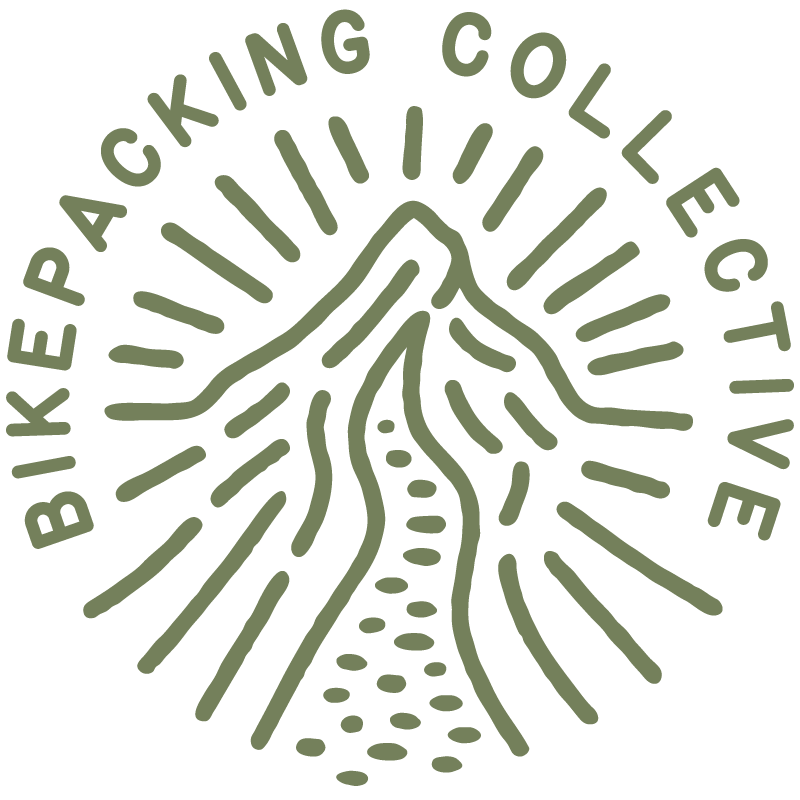
We're independent
and member-supported.
Join the Bikepacking Collective to make our work possible:







